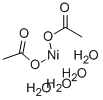Lead acetate trihydrate
Synonym(s):Lead diacetate trihydrate;Lead(II) acetate trihydrate
- CAS NO.:6080-56-4
- Empirical Formula: C4H12O7Pb
- Molecular Weight: 379.33
- MDL number: MFCD00212528
- EINECS: 612-031-2
- SAFETY DATA SHEET (SDS)
- Update Date: 2025-10-31 21:46:14

What is Lead acetate trihydrate?
Chemical properties
Lead acetate trihydrate, also known as plumbous acetate trihydrate, has the chemical formula Pb(C2H3O2)2·3H2O. It appears as a white, monoclinic crystalline solid. Upon heating it loses some of its water of crystallization, and after melting, decomposes at 200 °C. The trihydrate is highly soluble in water but insoluble in ethyl alcohol. It has an intensely sweet taste, hence it is sometimes called sugar of lead, but it is poisonous. The trihydrate is made by dissolving lead monoxide in hot dilute acetic acid solution; on cooling, large crystals separate, sometimes up to 60-cm long.
The Uses of Lead acetate trihydrate
Lead acetate trihydrate, the usual commercial form, is used in the preparation of basic lead carbonate and lead chromate, as a mordant in cotton dyes, as a reagent for the manufacture of lead salts of higher fatty acids, as a water repellant, as a component in combined toning and fixing baths for daylight printing papers, and as a means of treating awnings and outdoor furniture to prevent removal of mildew- and rotproofing agents by rain or laundering. Other uses include preparation of rubber antioxidants; processing agent in the cosmetic, perfume, and toiletry industries; component of coloring agents for adhesives; and preparation of organic lead soaps as driers of paints and inks.
The Uses of Lead acetate trihydrate
Lead(II) acetate trihydrate is used as a mordant in textile printing and dyeing, drier in paints, varnishes and as a water repellant. It is also used in cosmetics and to prepare other lead compounds. It serves as an ingredient in progressive types of hair coloring dyes. Further, it is used in the detection of poisonous gas hydrogen sulfide.
What are the applications of Application
Lead Acetate Trihydrate is a compound used as a fixative for some dyes
What are the applications of Application
Lead(II) acetate trihydrate was a component of the solution which was used towards the fabrication of platinum black microelectrodes. Lead acetate trihydrate may be used in the manufacturing of other lead salts. It may be used in the textile industry for dyeing and printing. In paint industry, lead acetate acts as a drying agent and as a purification agent in chemical synthesis.
General Description
Lead acetate trihydrate appears as white powder or white chunky solid. Slight odor. pH (5% aqueous solution at 77°F) 5.5-6.5. It is water soluble and stable under normal conditions.
Air & Water Reactions
Slowly effloresces in air. Water soluble but solutions absorb carbon dioxide from the air and to give incompletely soluble products.
Reactivity Profile
Lead acetate trihydrate may react with acids and oxidizing agents. Is incompatible with sulfates, citrates, tartrates, chlorides, carbonates, alkalis, tannin, resorcinol, salicylic acid, phenol, chloral hydrate, sulfites, vegetable infusions and tinctures. Incompatible with phosphates . Incompatible with KBrO3 and with EDTA.
Fire Hazard
Literature sources indicate that Lead acetate trihydrate is nonflammable.
Purification Methods
Crystallise it twice from anhydrous acetic acid and dry it under vacuum for 24hours at 100o. The solubility in H2O is 63% (at ~20o) and 200% (at boiling point). [Beilstein 2 IV 118.]
Properties of Lead acetate trihydrate
| Melting point: | 75 °C (dec.)(lit.) |
| Boiling point: | 280°C |
| Density | 2,55 g/cm3 |
| storage temp. | 2-8°C |
| solubility | 443g/l |
| form | Solid |
| color | White or colorless, efflorescent |
| Specific Gravity | 2.55 |
| PH | 5.5-6.5 (50g/l, H2O, 20℃) |
| Water Solubility | 625 g/L |
| Hydrolytic Sensitivity | 0: forms stable aqueous solutions |
| Merck | 14,5397 |
| BRN | 3730298 |
| Exposure limits | NIOSH: IDLH 100 mg/m3; TWA 0.050 mg/m3 |
| CAS DataBase Reference | 6080-56-4(CAS DataBase Reference) |
| EPA Substance Registry System | Lead(II) acetate trihydrate (6080-56-4) |
Safety information for Lead acetate trihydrate
| Signal word | Danger |
| Pictogram(s) |
 Corrosion Corrosives GHS05  Health Hazard GHS08  Environment GHS09 |
| GHS Hazard Statements |
H318:Serious eye damage/eye irritation H373:Specific target organ toxicity, repeated exposure H410:Hazardous to the aquatic environment, long-term hazard |
| Precautionary Statement Codes |
P202:Do not handle until all safety precautions have been read and understood. P260:Do not breathe dust/fume/gas/mist/vapours/spray. P273:Avoid release to the environment. P280:Wear protective gloves/protective clothing/eye protection/face protection. P305+P351+P338:IF IN EYES: Rinse cautiously with water for several minutes. Remove contact lenses, if present and easy to do. Continuerinsing. P308+P313:IF exposed or concerned: Get medical advice/attention. |
Computed Descriptors for Lead acetate trihydrate
| InChIKey | DYRQFRHCGBQJII-UHFFFAOYSA-M |
Lead acetate trihydrate manufacturer
JSK Chemicals
New Products
4,4-Difluoropiperidine hydrochloride tert-butyl 9-methoxy-3-azaspiro[5.5]undecane-3-carboxylate Indole Methyl Resin N-Isopropylurea N,N-Dicyclohexylcarbodiimide(DCC) MELDRUMS ACID 5-METHYLISOXAZOLE-4-CARBOXYLIC ACID Magnessium Bis glycinate Zinc ascorbate 1-bromo-2-butyne 2-acetamidophenol 9(10H)-anthracenone Erythrosin B, 4-Piperidinopiperidine 2-((4-morpholinophenylamino) (methylthio) methylene) malononitrile 2,4-dihydroxybenzaldehyde 3-(4-morpholinophenylamino)-5-amino-1H-pyrazole-4-carbonitrile Methyl 2-methylquinoline-6-carboxylate 2,6-dichloro-4-nitropyridine 4-Bromo-2-chlorobenzonitrile 2-(benzylamino)acetic acid hydrochloride 4-(tert-Butoxycarbonylamino)but- 2-ynoic acid 3,4-dihydro-2H-benzo[b][1,4]dioxepine 1-Phenyl-1-cycloprppanecarboxylicacidRelated products of tetrahydrofuran








You may like
-
 Lead acetate trihydrate 98%View Details
Lead acetate trihydrate 98%View Details -
 Lead(II) acetate trihydrate CAS 6080-56-4View Details
Lead(II) acetate trihydrate CAS 6080-56-4View Details
6080-56-4 -
 Lead(II) acetate trihydrate CAS 6080-56-4View Details
Lead(II) acetate trihydrate CAS 6080-56-4View Details
6080-56-4 -
 Lead(II) acetate trihydrate CAS 6080-56-4View Details
Lead(II) acetate trihydrate CAS 6080-56-4View Details
6080-56-4 -
 Lead(II) acetate trihydrate CAS 6080-56-4View Details
Lead(II) acetate trihydrate CAS 6080-56-4View Details
6080-56-4 -
 Lead(II) acetate trihydrate CAS 6080-56-4View Details
Lead(II) acetate trihydrate CAS 6080-56-4View Details
6080-56-4 -
 Lead(II) acetate trihydrate CAS 6080-56-4View Details
Lead(II) acetate trihydrate CAS 6080-56-4View Details
6080-56-4 -
 LEAD ACETATE TRIHYDRATE 99.5%, 6080-56-4View Details
LEAD ACETATE TRIHYDRATE 99.5%, 6080-56-4View Details
6080-56-4
